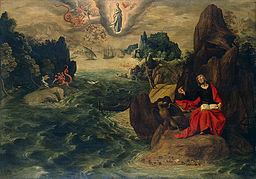 The Book of Revelation. G. R. Beasley-Murray. New Century Bible Commentary. Grand Rapids: Eerdmans, 1974. 352 pp.
The Book of Revelation. G. R. Beasley-Murray. New Century Bible Commentary. Grand Rapids: Eerdmans, 1974. 352 pp.
Introduction to the Unique Strengths and Usefulness of Beasley-Murray’s Commentary
Grant Osborne was the first person to point out to me the value of Beasley-Murray’s relatively concise commentary on Revelation. Beasley-Murray generally gets right to the point and is able to explain his approach to complex issues with clarity. Among his strengths are his references to extra-biblical Jewish literature, especially to those works that many scholars would describe as apocalyptic (like 1 Enoch). When he makes such references, Beasley-Murray generally points the reader to helpful parallels and explains how they are significant for shedding light on the book of Revelation. Beasley-Murray is worth consulting and reading with care, even though the book is now out of print.
Beasley-Murray’s Approach to the Book and to the Millennium
Beasley-Murray’s overall approach would fit within the historic premillennial camp, although I do not think that he provides a clear label for his approach anywhere in the commentary. It is helpful to be aware of two aspects of his approach that have significant consequences. First, like some historic premillennialists and all Dispensationalists, he places the 3½ year persecution of the church by the Beast in the future, right before the second coming of Christ (201). In my opinion, this causes him some difficulties in his interpretation of Revelation 11-19. For example, such a view makes it hard to relate the persecution of those chapters to the church in John’s day and to the church throughout the ages. The seven letters to the seven churches show that the church in John’s day, including John himself, is already experiencing persecution from the Beast (for example, Rev. 1:9; 2:10, 13). John is writing to give the church a proper perspective on this persecution and how to persevere in the midst of it.
A second important aspect of Beasley-Murray’s approach involves the Millennium. The informed reader can see that Beasley-Murray takes a helpful and unique approach to the Millennium of Revelation 20. Unlike most other historic premillennialists, he thinks that the “beloved city” (20:9) of the Millennium is the New Jerusalem of Revelation 21-22 (298). He shows how this view can allow for a plausible reading of Revelation 20:7-21:1. I am not aware of any other commentator who does such a helpful job of showing the explanatory power of seeing the city of the Millennium as the New Jerusalem.
Here is a link to Amazon.


The Book of Revelation by G. R. Beasley-Murray
Introduction to the Unique Strengths and Usefulness of Beasley-Murray’s Commentary
Grant Osborne was the first person to point out to me the value of Beasley-Murray’s relatively concise commentary on Revelation. Beasley-Murray generally gets right to the point and is able to explain his approach to complex issues with clarity. Among his strengths are his references to extra-biblical Jewish literature, especially to those works that many scholars would describe as apocalyptic (like 1 Enoch). When he makes such references, Beasley-Murray generally points the reader to helpful parallels and explains how they are significant for shedding light on the book of Revelation. Beasley-Murray is worth consulting and reading with care, even though the book is now out of print.
Beasley-Murray’s Approach to the Book and to the Millennium
Beasley-Murray’s overall approach would fit within the historic premillennial camp, although I do not think that he provides a clear label for his approach anywhere in the commentary. It is helpful to be aware of two aspects of his approach that have significant consequences. First, like some historic premillennialists and all Dispensationalists, he places the 3½ year persecution of the church by the Beast in the future, right before the second coming of Christ (201). In my opinion, this causes him some difficulties in his interpretation of Revelation 11-19. For example, such a view makes it hard to relate the persecution of those chapters to the church in John’s day and to the church throughout the ages. The seven letters to the seven churches show that the church in John’s day, including John himself, is already experiencing persecution from the Beast (for example, Rev. 1:9; 2:10, 13). John is writing to give the church a proper perspective on this persecution and how to persevere in the midst of it.
A second important aspect of Beasley-Murray’s approach involves the Millennium. The informed reader can see that Beasley-Murray takes a helpful and unique approach to the Millennium of Revelation 20. Unlike most other historic premillennialists, he thinks that the “beloved city” (20:9) of the Millennium is the New Jerusalem of Revelation 21-22 (298). He shows how this view can allow for a plausible reading of Revelation 20:7-21:1. I am not aware of any other commentator who does such a helpful job of showing the explanatory power of seeing the city of the Millennium as the New Jerusalem.
Here is a link to Amazon.

